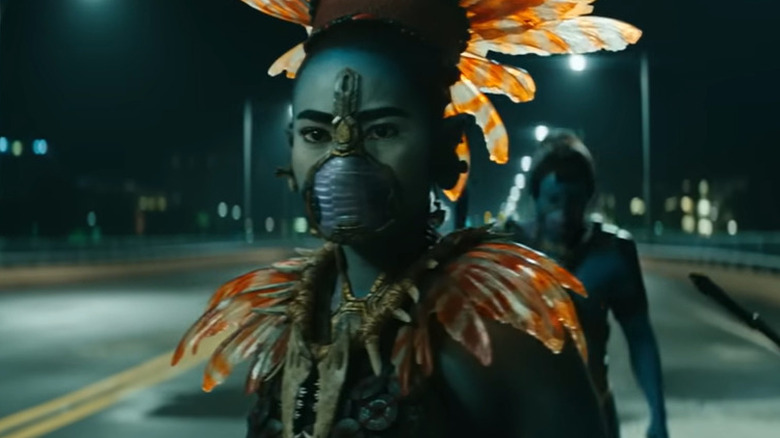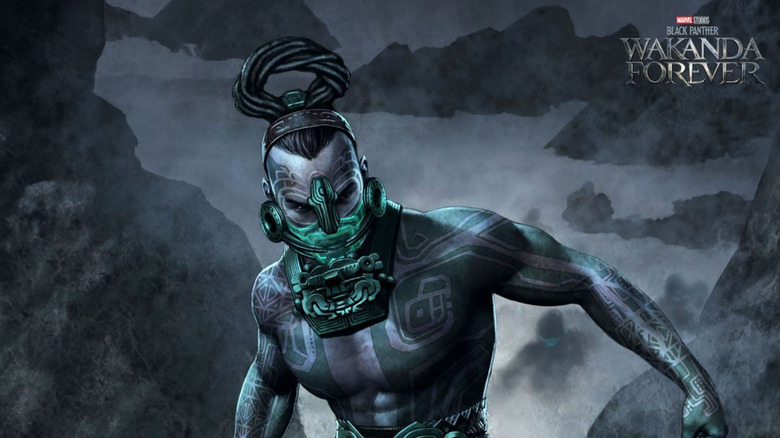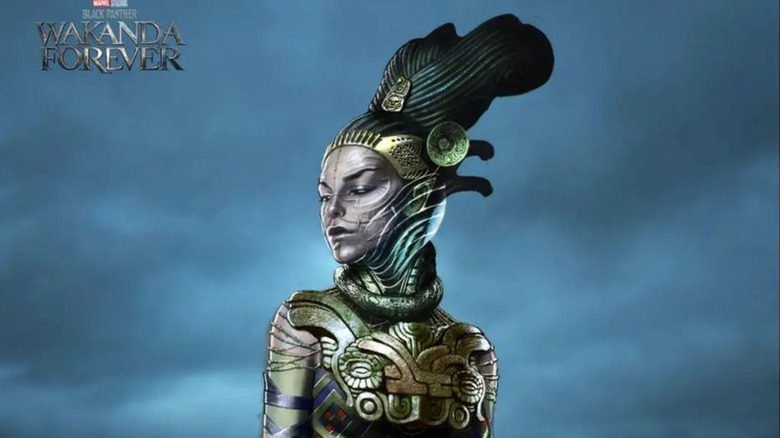Black Panther: Wakanda Forever Concept Art Shows A Different Take On The People Of Talokan
The Talokani of "Black Panther: Wakanda Forever" have developed a fanbase of their own, in part due to their iconic salute and charismatic leader, Namor. That's not even accounting for the aquatic race's snazzy outfits, which inspire both fear and awe due to their combination of ancient Mayan elements and disconcerting — yet practical — breathing apparatuses. But those striking outfits would have looked slightly different if early character designs had made it into the final cut of "Wakanda Forever." Judging by Instagram posts from one of the movie's designers, the Talokani were almost svelte fashion models.
On top of that, an early design would have even made the Talokani copper-skinned, thus creating a more noticeable contrast between the early iterations of the Talokani and the blue-skinned warriors we've come to know. As fans recall, the Talokani were imbued with different powers from their god-like leader, thus inspiring their turquoise appearance. With that said, perhaps it's time to dig into these new, unearthed character designs.
Outfits were inspired by an alternate reality version of history
Though the Talokani in "Black Panther: Wakanda Forever" wore armor inspired by real Mayan iconography, their counterparts from early designs were even more Mayan-looking. According to images shared by "Wakanda Forever" designer Adi Granov, an early iteration of the Talokani would have included a man flaunting what appears to be jade armor and jewelry. In Mayan tradition, jade was considered a symbol of centrality and a material embodiment of the "breath," or soul (via JSTOR). Perhaps it's not surprising, then, that this early character would have also used a jade breathing apparatus.
In one of his posts, Granov revealed that his concept art for the Talokani was motivated by his desire to blend history with fiction. "I was hugely inspired by my trip to Mexico and tried to do a kind of alternate reality version of ancient designs as if they developed by branching out hundreds of years ago," he wrote. During his trip to Mexico, Granov undoubtedly would have encountered Mayan textiles and iconography, thus influencing the appearance of the Talokani, who descended — like Namor — from the Yucatán Maya.
This design wasn't the only possible change to the appearance of the Taolkani in early designs, however.
The Talokani weren't blue-skinned in every design
Another of Adi Granov's designs depicts a sort of Talokani warrior princess bedecked with facial etchings, gold jewelry, and flashy armor bearing traditional Mayan patterns. In addition to those very Mayan elements, however, she also wears a hairstyle more befitting of an ancient Nubian queen. Her silhouette, gloves, and hand wraps also seem to suggest a modern sensibility. The overall effect is a svelter, more sensual version of the Talokani warriors than the appearance depicted in "Wakanda Forever." Notably, an accompanying image shows the same woman possessing copper, not blue, skin. Viewers will remember that in "Wakanda Forever," the Talokani became blue-skinned thanks to a ritual with Vibranium that took place hundreds of years before the events of the movie. On the other hand, their leader Namor, a long-time staple of "Black Panther" history, gained god-like powers and retained his original skin color, thus creating a visual delineation between him and his subjects.
In any case, Granov's Instagram posts provide an invaluable glimpse into the lengthy, complicated process that went into the making of "Wakanda Forever." Marvel fans can only hope that Granov, who also worked on concept art for "Iron Man" and "The Avengers," will contribute his many talents to future Marvel projects.


